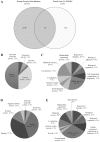Urinary biomarkers for the diagnosis of cervical cancer by quantitative label-free mass spectrometry analysis
- PMID: 31186765
- PMCID: PMC6507435
- DOI: 10.3892/ol.2019.10227
Urinary biomarkers for the diagnosis of cervical cancer by quantitative label-free mass spectrometry analysis
Abstract
Due to the invasive procedure associated with Pap smears for diagnosing cervical cancer and the conservative culture of developing countries, identifying less invasive biomarkers is of great interest. Quantitative label-free mass spectrometry was performed to identify potential biomarkers in the urine samples of patients with cervical cancer. This technique was used to study the differential expression of urinary proteomes between normal individuals and cancer patients. The alterations in the levels of urinary proteomes in normal and cancer patients were analyzed by Progenesis label-free software and the results revealed that 60 proteins were upregulated while 73 proteins were downregulated in patients with cervical cancer. This method could enrich high molecular weight proteins from 100 kDa. The protein-protein interactions were obtained by Search Tool for the Retrieval of Interacting Genes/Proteins analysis and predicted the biological pathways involving various functions including cell-cell adhesion, blood coagulation, metabolic processes, stress response and the regulation of morphogenesis. Two notable upregulated urinary proteins were leucine-rich α-2-glycoprotein (LRG1) and isoform-1 of multimerin-1 (MMRN1), while the 3 notable downregulated proteins were S100 calcium-binding protein A8 (S100A8), serpin B3 (SERPINB3) and cluster of differentiation-44 antigen (CD44). The validation of these 5 proteins was performed by western blot analysis and the biomarker sensitivity of these proteins was analyzed individually and in combination with receiver operator characteristic curve (ROC) analysis. Quantitative mass spectrometry analysis may allow for the identification of urinary proteins of high molecular weight. The proteins MMRN1 and LRG1 were presented, for the first time, to be highly expressed urinary proteins in cervical cancer. ROC analysis revealed that LRG1 and SERPINB3 could be individually used, and these 5 proteins could also be combined, to detect the occurrence of cervical cancer.
Keywords: S100A8; cervical cancer; cluster of differentiation 44 antigen; label-free; leucine-rich α-2-glycoprotein; multimerin-1; serpin B3; urinary biomarkers.
Figures




References
-
- Ferlay J, Soerjomataram I, Ervik M, Dikshit R, Eser S, Mathers CD, Rebelo M, Parkin DM, Forman D, Bray F. 11 [Internet] Lyon, France: International Agency for Research on Cancer; 2013. [Dec 10;2016 ]. GLOBOCAN 2012 v1.0, cancer incidence and mortality worldwide: IARC cancer base No.
LinkOut - more resources
Full Text Sources
Other Literature Sources
Research Materials
Miscellaneous
